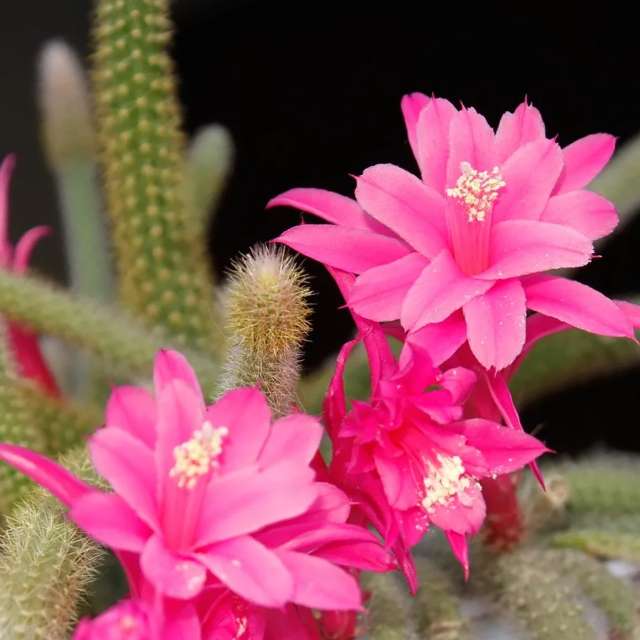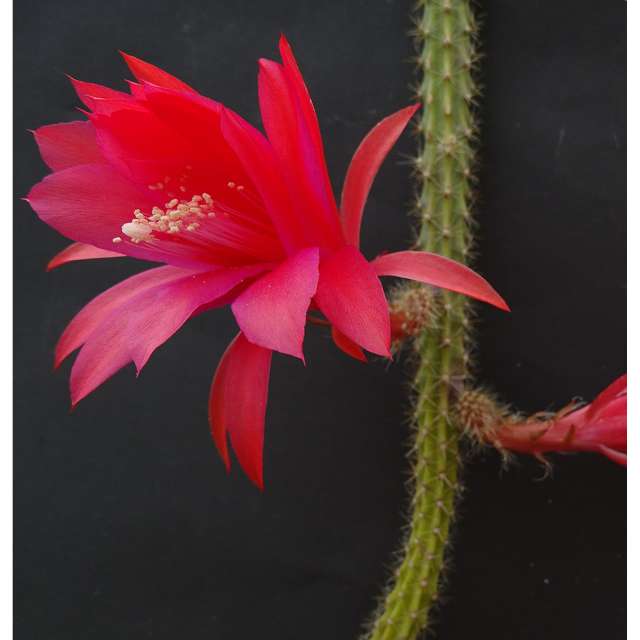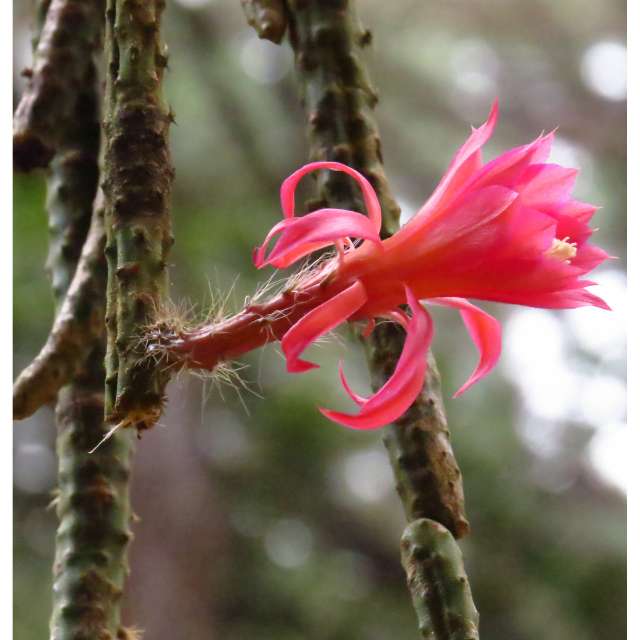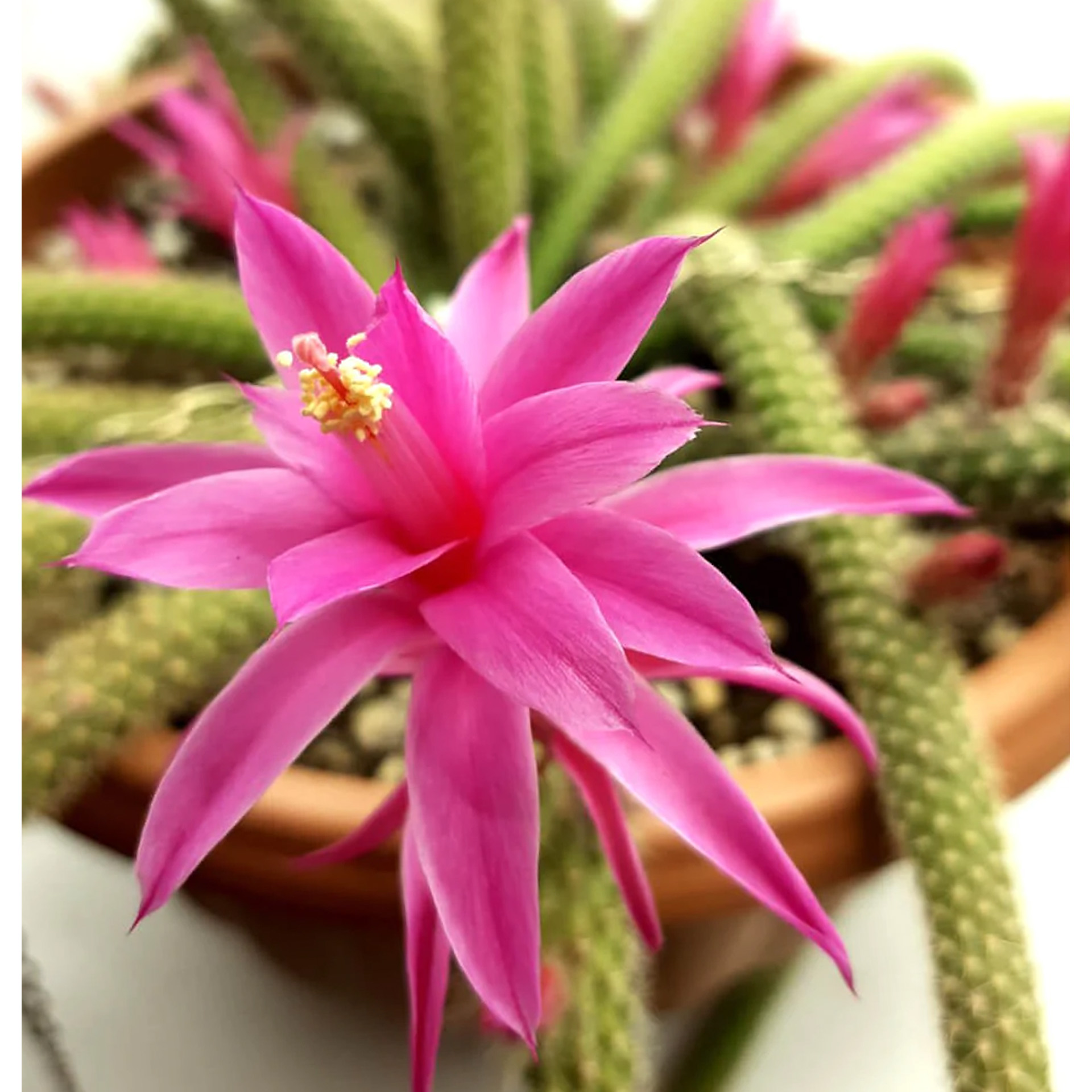Latin name: Aporocactus
Category: epiphytic plant
Origin: Southern and Central Mexico, Tropics of Central America
Aporocatus – an epiphyte plant
Culture can be found in natural conditions on rocks, slopes among stones clinging to the branches of trees and shrubs.
The fleshy stem of a cactus is three centimeters in diameter, one meter in height. The appearance of the stems is branched, at an older age the stems hang down. The stems grow five meters creeping with many shoots with aerial roots. Ribbed with small dense spines, bright green with crimson or pink flowers. The cactus contains red, rounded fruits with soft bristles.
When grown at home, the stems grow no more than one meter, and in diameter from 1 to 1.5 cm. They are grown as an ampelous plant in flowerpots, as well as the place of growth is the bark of a cork tree. Falling shoots with a lot of color look unusually beautiful.
In winter, the plant blooms with elongated and large flowers from 6 to 10 cm in length, crimson, red, lilac. The flowering period is long from the end of winter to half of the summer period.
The advantage of a cactus is to release oxygen at night, and carbon dioxide during the day.
Ideal location of the plant next to the TV or computer, due to its ability to absorb electromagnetic radiation.
Dizocactus is popular for growing indoors. Due to undemanding care, it is a charming decoration of loggias, window sills of apartments.
Types of Aporocactus
Five species of this plant are known. The most popular among them.
Whip aporocactus (Aporocactus flagelliformis)
 The plant is distinguished by a stem with a branching of green color along a length of one meter. Young cacti have stems that grow upwards, then descend downwards with development. Flowering time in March or April for four days. At the end of flowering, red fruits with sharp spines form in place of dried inflorescences.
The plant is distinguished by a stem with a branching of green color along a length of one meter. Young cacti have stems that grow upwards, then descend downwards with development. Flowering time in March or April for four days. At the end of flowering, red fruits with sharp spines form in place of dried inflorescences.
Aporocactus conzatti (Aporocactus conzattii)
 Cactus with whip-like or creeping broad stems are green in color, containing small brown spines. Large red inflorescences are about 9 cm long. In nature, the plant prevails to grow on the seashore on tall trees.
Cactus with whip-like or creeping broad stems are green in color, containing small brown spines. Large red inflorescences are about 9 cm long. In nature, the plant prevails to grow on the seashore on tall trees.
Aporocactus Martius (Aporocactus martianus)
 It has a long branched stem containing low ribs and thin gray spines. Large pink flowers about 10 cm in diameter.
It has a long branched stem containing low ribs and thin gray spines. Large pink flowers about 10 cm in diameter.
Disocactus room care
Caring for a plant at home is not particularly difficult. The necessary conditions for good development are the same as for ampelous epiphytes.
Choice of location and lighting
The plant is more suitable places with bright lighting, but does not withstand direct sunlight. The optimal places for the plant are in the east and west of the room. On the south side, it is allowed to grow, shading the cactus during extreme heat. When cold weather sets in, it is also necessary to provide the cactus with good lighting.
Thanks to such an important condition as good lighting, buds will form abundantly.
Temperature rules
In warm periods of the year, the cactus is acceptable temperature from 22 to 25 ℃. The plant in the summer is recommended to be outdoors with diffused lighting. At the onset of late autumn time and in winter, the aporocactus is comfortable in a cool and bright room, at a temperature not higher than 11℃.
Soil for disocactus
The most suitable soil for the plant is airy, neutral in acidity with drainage. When buying soil, you should purchase soil for succulents and dilute it with small gravel. You can make it yourself from humus, leafy soil, coarse sand and pebbles, the required proportion of the composition is 1: 3: 1: 2. Due to the fact that the root system of the plant is weak, plants should be planted in low flowerpots with holes.
Watering
We water in spring and summer plentifully, but without waterlogging of the soil. It is necessary to maintain regular soil moisture. Every time after watering, after some time, you need to pour out excess water. With the onset of cold weather, watering is reduced. The plant needs to be watered when the soil dries completely.
Cacti, when placed in places with frequent rains or with excessive watering, rot and become soft.
Air humidity
Normal air humidity is suitable for the plant. In the summer, many flower growers recommend spraying with water.
In winter, spraying is prohibited.
Top dressing for disocactus
Epiphytic plants need fertilizer in the period March-July at intervals of a month once. All fertilizers for cacti are suitable for feeding.
At the end of flowering, no fertilizer is needed.
Aporocactus transplant
Young plants are transplanted once a year, adults need a transplant once every three years. When transplanting cacti, we purchase flowerpots of a larger size in width than the previous one. This should be done in connection with the superficial root system of cacti. Drainage is required. For planting, we take loose turf, low-lying peat, river sand, granite chips, all in equal parts, small brick fragments are half as much as all the components of the substrate. You can also add charcoal.
Propagation of disocactus
Cacti are propagated by cuttings and seeds.
Cuttings are cut from the top of the shoots along a length of 5 to 7 cm; reproduction can also be done using broken off daughter branches. Let them dry for two days. After that, pour the soil into a wide flowerpot, and at the top make a layer of fine gravel 5 cm and stick bamboo sticks. Then you should tie the stalk with woolen threads to the stick.
Place no more than five cuttings in a flowerpot. We don’t water for a week, then we moisten the ground a little with a spray gun, without getting water on the cactus. Roots will appear after two weeks. Before rooting, you need to cut the stalk in the shape of a cone – it helps to develop a strong root system.
The sticks must be removed after the cactus is well rooted.
Many are interested in the question of how to plant a cactus without roots.
We stand the process for some time in coolness and darkness. When the cut place dries, we plant it in a small container about 2 cm larger for the process. During watering, do not allow the water to stagnate so that the root system does not rot. Holes are required in the container to avoid root rot.
A few other important tips should also be mentioned:
- We take sandy soil for planting the shoot.
- You should not cover the process with earth, you just need to put a cut on the soil.
- When watering, we observe that the process is in its place and does not move.
- When the roots appear, we plant the process. In the flowerpot at the beginning we settle the expanded clay, then pour the soil. We make a small depression in the soil and plant a shoot. We do not water during the first week, but spraying is necessary.
Pests and diseases of aporocactus
Plants are resistant to changes in environmental conditions. Aporocactus is exposed to pests, the most dangerous for him is the invasion of the spider mite. The pest sucks the juice of the plant, after which the green mass turns yellow. To combat spider mites, spraying with insecticides is used. The appearance of the pest contributes to dry air.
The most common disease is rot, which occurs with excessive moisture in the earth, as well as at low temperatures.
To save the cactus, it is necessary to remove the rotten areas and treat the cuts with fungicides and charcoal.
Difficult moments when growing dysocactus
- Drying of the end of the stem, rot at the base – excessive watering.
- Slow growth – underwatering in summer or overwatering in winter.
- Stretching the stem – insufficient lighting.
A variety of beautiful and charming cacti will create a real collection. Not requiring special care. Unusual and beautiful cacti will create a spectacular and original look for your home interior.
For those who want to read or grow plants, you can use the catalog of indoor plants from a to z. There are many beautiful flowers in it: adenium, akalifa, bilbergia, bougainvillea, wallot, gardenia, diplatia, irezine, camellia, clivia and others.















Write comments
Comments